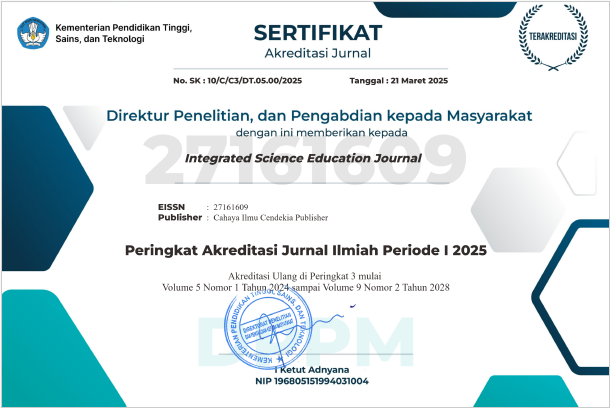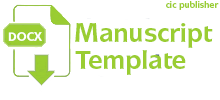Digital Literacy Dimensions in High School Education: From Operational Skills to Privacy Awareness
Abstract
Purpose of the study: This study aims to measure digital literacy, encompassing operational skills, content creation, information search, information evaluation, and privacy protection, providing insights for targeted educational interventions.
Methodology: A quantitative survey using a 21-item structured questionnaire based on established digital literacy frameworks was conducted with 898 students through Google Forms. Content validity was confirmed by expert review, and reliability by Cronbach’s Alpha (>0.80). Data analysis employed SPSS 25 with t-test, ANOVA, and correlation.
Main Findings: Students showed consistently high operational skills, content creation, and information evaluation (100% “Good”); information search scored Very Good 16.67% and Good 83.33%. Privacy protection varied (Very Good 11.11%, Good 66.67%, Fair 22.22%). Operational skills correlated moderately with privacy protection (R=0.437; R²=0.191), indicating that technical proficiency alone does not ensure secure online behavior.
Novelty/Originality of this study: This study uniquely integrates privacy protection as a central dimension of digital literacy and analyzes its relationship with operational skills among high school students. It advances knowledge by linking technical ability to safe online behavior, offering evidence-based insights for curriculum design, teacher training, and policies promoting digital resilience.
References
M. Muchdie, “the Impacts of Technological Progress on Human Development : Evidence From Indonesia,” Int. J. Econ. Res., vol. 7, no. 5, pp. 14–28, 2016, doi: 10.1080/14649880500120491.United.
S. A. Crossley and D. S. McNamara, “Adaptive educational technologies for literacy instruction,” Adapt. Educ. Technol. Lit. Instr., pp. 1–310, 2016, doi: 10.4324/9781315647500.
Z. Lokmic-Tomkins, D. Choo, P. Foley, S. Dix, P. Wong, and G. Brand, “Pre-registration nursing students’ perceptions of their baseline digital literacy and what it means for education: A prospective COHORT survey study,” Nurse Educ. Today, vol. 111, p. 105308, 2022, doi: 10.1016/j.nedt.2022.105308.
M. Bartsch and T. Dienlin, “Control your Facebook: An analysis of online privacy literacy,” Comput. Human Behav., vol. 56, pp. 147–154, Mar. 2016, doi: 10.1016/J.CHB.2015.11.022.
T. Svensson, J. Wilk, and K. Gustafsson Åman, “Information literacy skills and learning gaps– Students’ experiences and teachers’ perceptions in interdisciplinary environmental science,” J. Acad. Librariansh., vol. 48, no. 1, p. 102465, 2022, doi: 10.1016/j.acalib.2021.102465.
K. Jose, “Digital literacy matters. Increasing workforce productivity through blended English language programmes.,” High. Learn. Res. Commun., vol. 6, no. 4, 2016, doi: 10.18870/hlrc.v6i4.354.
A.-A. Deschênes, “Digital literacy, the use of collaborative technologies, and perceived social proximity in a hybrid work environment: Technology as a social binder,” Comput. Hum. Behav. Reports, vol. 13, p. 100351, 2024, doi: 10.1016/j.chbr.2023.100351.
R. Suson, “Digital Citizenship in Education: Visioning Safety and Responsibilities in Digital World,” Int. J. Trend Sci. Res. Dev., 2019, [Online]. Available: https://api.semanticscholar.org/CorpusID:202328535
H. E. Julien, “Digital Literacy in Theory and Practice,” Adv. Libr. Inf. Sci., 2019, [Online]. Available: https://api.semanticscholar.org/CorpusID:158196663
A. Caton, D. Bradshaw-Ward, Kinshuk, and W. Savenye, “Future Directions for Digital Literacy Fluency using Cognitive Flexibility Research: A Review of Selected Digital Literacy Paradigms and Theoretical Frameworks,” J. Learn. Dev., vol. 9, no. 3, pp. 381–393, 2022, doi: 10.56059/jl4d.v9i3.818.
S. Sujarwoto and G. Tampubolon, “Spatial inequality and the Internet divide in Indonesia 2010–2012,” Telecomm. Policy, vol. 40, no. 7, pp. 602–616, 2016, doi: 10.1016/j.telpol.2015.08.008.
Katadata Insight Center, “Status Literasi Digital di Indonesia Ringkasan Eksekutif,” 2021, [Online]. Available: https://katadata.co.id/StatusLiterasiDigital
S. Purnama, M. Ulfah, I. Machali, A. Wibowo, and B. S. Narmaditya, “Does digital literacy influence students’ online risk? Evidence from Covid-19,” Heliyon, vol. 7, no. 6, p. e07406, Jun. 2021, doi: 10.1016/J.HELIYON.2021.E07406.
K. Z. Ya, F. Rizal, A. A. Ramadhan, and Mandalika, “Educational supply chain management: A case study in Indonesia,” Horiz., vol. 15, no. 1, pp. 15–27, 2007, doi: 10.1108/10748120710735239.
H. Rinardi, “Java and Outer Island: Economic Inequality and Inter-Island Shipping Policy in Indonesia until the 1960s,” E3S Web Conf., vol. 202, 2020, doi: 10.1051/e3sconf/202020207070.
KIC, “Indeks Literasi Digital Berdasarkan Wilayah di Indonesia,” p. 2022, 2022.
H. Choudhary and N. Bansal, “Addressing Digital Divide through Digital Literacy Training Programs: A Systematic Literature Review,” Digit. Educ. Rev., no. 41, pp. 224–248, 2022, doi: 10.1344/DER.2022.41.224-248.
T. Heponiemi, K. Gluschkoff, L. Leemann, K. Manderbacka, A. M. Aalto, and H. Hyppönen, “Digital inequality in Finland: Access, skills and attitudes as social impact mediators,” New Media Soc., vol. 25, no. 9, pp. 2475–2491, Jul. 2021, doi: 10.1177/14614448211023007.
N. S. Goedhart, P. Verdonk, and C. Dedding, “‘Never good enough.’ A situated understanding of the impact of digitalization on citizens living in a low socioeconomic position,” Policy and Internet, vol. 14, no. 4, pp. 824–844, 2022, doi: 10.1002/poi3.315.
F. P. B. Mota and I. Cilento, “Competence for internet use: Integrating knowledge, skills, and attitudes,” Comput. Educ. Open, vol. 1, no. August, p. 100015, 2020, doi: 10.1016/j.caeo.2020.100015.
R. S. Hirschprung, T. Shay, and E. and Reznik, “Optimising technological literacy acquirement to protect privacy and security,” Behav. Inf. Technol., vol. 41, no. 5, pp. 922–933, Apr. 2022, doi: 10.1080/0144929X.2020.1842907.
L. A. Thuy Nguyen and A. Habok, “A study on Vietnamese undergraduates’ level of digital skills and the frequency of using digital tools in the EFL context,” in Proceedings of the 22nd International Conference on Computer Systems and Technologies, in CompSysTech ’21. New York, NY, USA: Association for Computing Machinery, 2021, pp. 171–175. doi: 10.1145/3472410.3472425.
F. Bélanger and R. E. Crossier, “Privacy in the digital age: A review of information privacy research in information systems,” MIS Quart., vol. 35, no. 4, pp. 1017–1041, 2011, doi: 10.2307/41409971.
A. F. Sadeli and I. Irawati, “Awareness of Personal Data Protection Law in concern to literacy,” J. Kaji. Inf. Perpust., vol. 11, no. 2, p. 241, 2023, doi: 10.24198/jkip.v11i2.47526.
A. Martin and J. Grudziecki, “DigEuLit: Concepts and Tools for Digital Literacy Development,” Innov. Teach. Learn. Inf. Comput. Sci., vol. 5, no. 4, pp. 249–267, 2006, doi: 10.11120/ital.2006.05040249.
J. Vanek, “Digital literacy this brief what does it mean to have digital literacy skills?,” p. 7, 2010.
J. Atenas, L. Havemann, and C. Timmermann, “Critical literacies for a datafied society: Academic development and curriculum design in higher education,” Res. Learn. Technol., vol. 28, no. 1063519, pp. 1–14, 2020, doi: 10.25304/rlt.v28.2468.
A. Frik, J. Kim, J. R. Sanchez, and J. Ma, “Users’ Expectations About and Use of Smartphone Privacy and Security Settings,” Conf. Hum. Factors Comput. Syst. - Proc., 2022, doi: 10.1145/3491102.3517504.
M. S. Alzaidi and G. Agag, “The role of trust and privacy concerns in using social media for e-retail services: The moderating role of COVID-19,” J. Retail. Consum. Serv., vol. 68, no. March, p. 103042, 2022, doi: 10.1016/j.jretconser.2022.103042.
E. Goffman, The Presentation of Self In Everyday Life. New York: The Overlook Press, 1959.
M. K. Sharma, N. Anand, B. N. Roopesh, and S. Sunil, “Digital resilience mediates healthy use of technology,” Med. Leg. J., vol. 90, no. 4, pp. 195–199, 2022, doi: 10.1177/00258172211018337.
B. Adhikara, “Journal Review: Identifying Predictors of Digital Competence of Educators and Their Impact on Online Guidance,” Pap. - Multidiscip. Sci. J. Innov. Res., vol. 1, no. 3, pp. 21–23, 2023, doi: 10.59178/papernia.202301033.
F. Romana, N. Alfiani, and R. Sara, “The Improvement Of Digital Literacy To Secure Data And Privacy In The Digital Age,” Digit. Lit. is Essent. Navig. online spaces ensuring safe Eff. Commun. today’s Digit. era, Pers. data Priv. are interconnected concepts crucial Individ. rights Prot. an increasingly Digit., vol. 3, no. 12, pp. 832–839, 2024, doi: 10.58631/injurity.v3i12.1374.
C. Sindermann, H. S. Schmitt, F. Kargl, C. Herber, and C. Montag, “Online Privacy Literacy and Online Privacy Behavior – The Role of Crystallized Intelligence and Personality,” Suppl. Mater. Online, pp. 1–23, 2021.
T. P. N. T. Shariman, N. A. Razak, and N. F. M. Noor, “Digital literacy competence for academic needs: An analysis of malaysian students in three universities,” Procedia - Soc. Behav. Sci., vol. 69, no. Iceepsy, pp. 1489–1496, 2012, doi: 10.1016/j.sbspro.2012.12.090.
Copyright (c) 2025 Nursida Arif, Muhammad Nursa’ban, Mukminan Mukminan, Meily Sari

This work is licensed under a Creative Commons Attribution 4.0 International License.
Authors who publish with this journal agree to the following terms:
- Authors retain copyright and acknowledge that the Integrated Science Education Journal is the first publisher licensed under a Creative Commons Attribution 4.0 International License.
- Authors are able to enter into separate, additional contractual arrangements for the non-exclusive distribution of the journal's published version of the work (e.g., post it to an institutional repository or publish it in a book), with an acknowledgment of its initial publication in this journal.
- Authors are permitted and encouraged to post their work online (e.g., in institutional repositories or on their website) prior to and during the submission process, as it can lead to productive exchanges and earlier and greater citation of published work.







.png)
.png)






